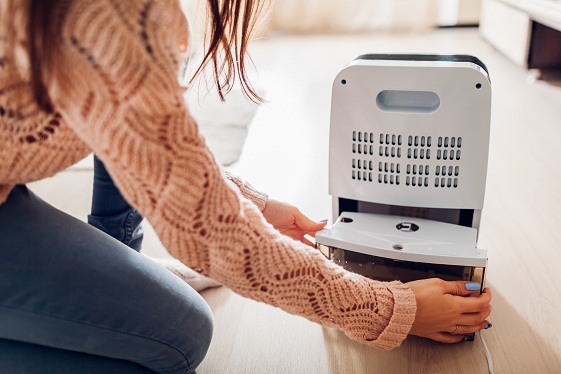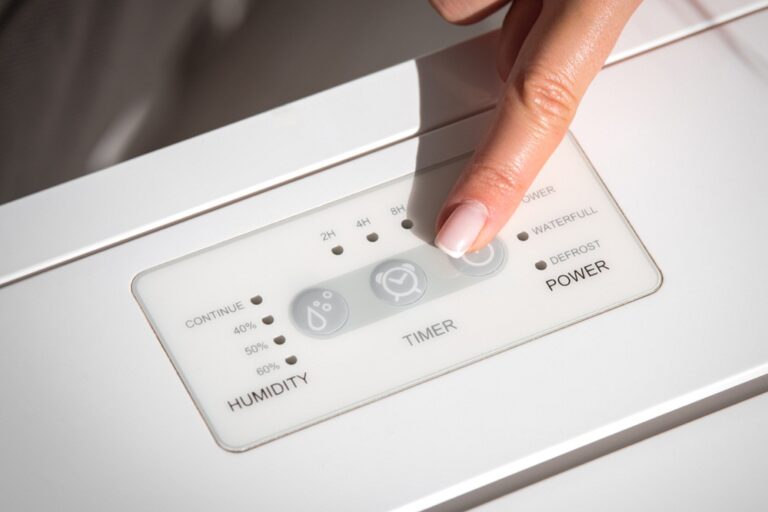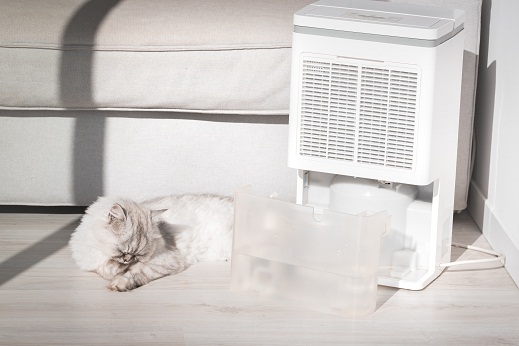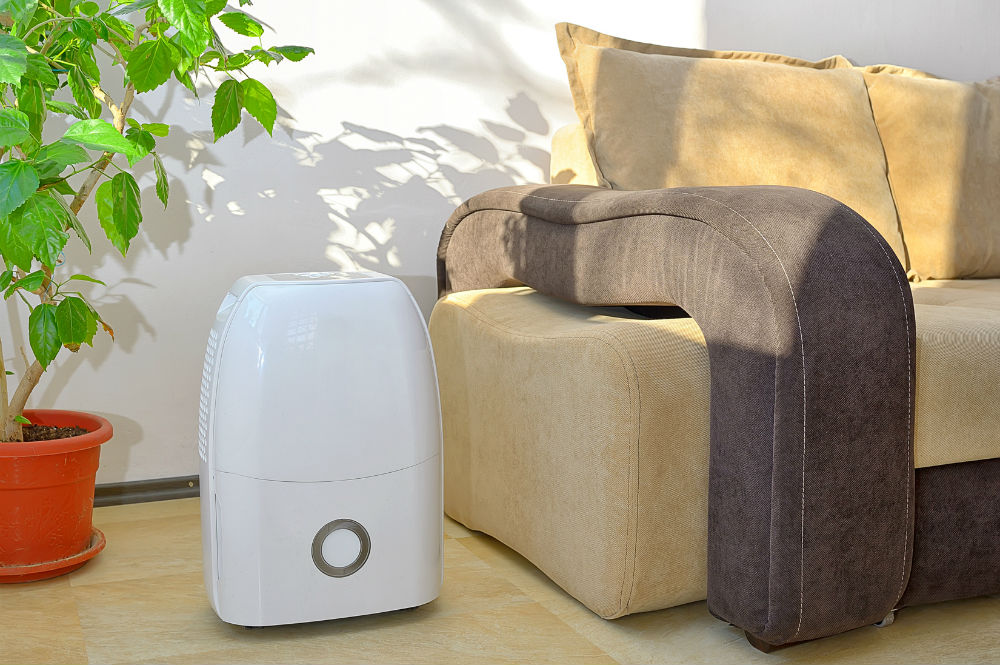When you move your dehumidifier do you notice it is leaking from the bottom?
Is there a pool of water gathering under the unit near a wall socket?
Then you may be asking yourself: why is my dehumidifier leaking water on the ground?
There are several reasons why a dehumidifier system might be leaking water, but whatever the cause it’s a frustrating and possibly hazardous situation that needs to be taken care. Otherwise, your flooring can get damaged – or someone might slip and fall.
In this article, we explain how to debug a leaky dehumidifier and correct the problem before someone – or something – gets hurt.
Dehumidifier Keeps Leaking on Floor
A leaking dehumidifier may wind up causing exactly the kind of problem you’re trying to solve. If water is allowed to sit on the carpet, it may damage it badly.
Wood or lino may spoil over time due to this as well.
Standing water can be a breeding pool for bacteria, resulting in health issues or affecting people with continuing medical conditions. Apart from the humidity and potential mold, a dehumidifier leaking from the floor can cause an unpleasant odor.
So why is your dehumidifier leaking, and how do you stop it?
There are some basic things you can do to learn what’s happening and fix it.
Four Common Causes of Water Leakage
- 1. The position of this collection barrel is inaccurate. Make sure that the bucket is under the coil.
- 2. The float switch is stuck and the collection bucket is blocked. It can't switch off the dehumidifier. Eliminate the collection bucket out of the dehumidifier to assess if the float can move up and down freely.
- 3. The drainpipe in the evaporator pot to the collection barrel is blocked, and water isn't allowed to drain into the socket correctly. Eliminate the collecting bucket and discover the drainpipe on the drip tray. Push a little straw to the tube to clear the obstruction.
- 4. The bucket is damaged or broken. Remove the bucket, wipe off dust and water, and then check if there are holes or cracks if the drain hose or adapter is damaged or loose. Check if the hose adapter is appropriately inserted into the drip tray. Secure the drain hose to which the adapter is attached.
Check the Water Collection Bucket

Non-permanent or portable dehumidifiers have a reservoir or bucket to collect the water rather than a hose to move it directly to a drain. This container should be vacant to keep it from overflowing or water standing in it for a long time.
If you leave water in your system, even if it’s not working, the water can get stagnant and breed mold and mildew. Due to this, you should make sure that you empty it regularly and wash it clean with a soft cloth.
So first, check your water collection bucket. Make sure it’s empty and the filter that the water passes through is not blocked by anything. Most dehumidifiers have an easily detachable bucket, and some even have a system that shuts off automatically if the dehumidifier is too full.
Is Your Hose Blocked?
Fixed Dehumidifiers permanently fixed on a wall or in a crawl space often have a hose that takes the water right from the system and into a drain. If this hose becomes clogged, you could see water being unable to break free from the unit efficiently, leading to the device getting backed up.
Unplug your dehumidifier from the power and separate the hose which leads to the drain. Run your hands down the hose and feel for any bends or kinks causing your unit troubles.
Then remove the hose altogether from the device and wash it thoroughly in a bucket of water. Using freshwater, flow the water through the hose and check it is coming out quickly. There are many great sources online that demonstrate how you can step by step clear a blocked hose.
Frigidaire Dehumidifier Not Draining
You should also see the drain for blockages. Even if something obstructs the drain away from the unit, this may make the water back up and pressure can cause leaks in the hose, or the pipe reaches the dehumidifier itself.
Make Sure the Pump is Working
Some dehumidifiers use gravity to drain the water awa, and for components that are mounted high on a wall or in a raised position, this generally works fine. Yet for some dehumidifiers, possibly on your crawlspace or not being repaired in a high place; a pump would be the best way to remove water from the device itself.
Among the first things to check with your pump is to see whether it’s clogged or blocked. If there is any debris within the unit, this can cause your unit to leak water on the floor.
The other reason that your pump may have stopped working is a loss of electricity. Check for a faulty connection or loose wires to the component itself.
Look for Ice
If your dehumidifiers have been working in temperatures below 65 degrees, you might get the coils within the device to have iced over. Dehumidifiers pull air through a filter and then pass it over trendy coils that condense the water in the air and collect it in a bucket.
If the dehumidifier got too cold, you might find it’s stopped working properly when the temperature increases again. This could result in water leaking from the base of your dehumidifier, the ice melts.
To de-ice your dehumidifier, raise the room’s temperature and clean the coils with a soft cloth till they return to the required operating temperature.
Has the Overflow Switch Stopped Working?

Another cause for a dehumidifier leaking is if the overflow change is now faulty and ceased working. Many dehumidifier systems have an integrated system, which prevents them from overflowing and will remove the dehumidifier unit if the bucket gets too full.
How to Fix Condensate Pump -- Change Broken Switch
It can be hard to determine whether this “float switch” in the dehumidifier is running just by taking a look at the unit and if you leave it working and it’s broken, you will shortly have a puddle to take care of! One of the simplest ways to test whether the change is working is with a volt-ohm meter.
Unplug the dehumidifier, make the change you think is not working. Disconnect the leads from the switch and hook up the volt-ohm meter, then assess your water bucket is empty Lastly, check if the device is free of any blockages.
Then place the meter on the RX1 scale and then trigger the switch. If there’s absolutely no movement on the meter as the switch is flicked on and off, then it’s damaged.
Conclusion
The fact of the matter is this; a dehumidifier can and possibly will flow water or ice up no matter if it’s a Delonghi, Kenmore, Frigidaire, or Whirlpool.
The brand makes no difference since this is simply a frequent occurrence in these units..So, if you are trying to work out why your dehumidifier system is leaking water onto the floor, follow these steps and check them off as you go.
- Vacant the water collection bucket
- Unclog the pipe and check it isn't kinked
- Make sure the pump is working well
- Verify your dehumidifier operating in a room that's the ideal temperature
- Check the overflow switch
I’m a degreed ME (mechanical engineer) who is passionate about machines of all kinds. I created MachineWonders.com as a way to connect with others who love machines like me – or need help choosing one for their needs, application, or situation.



